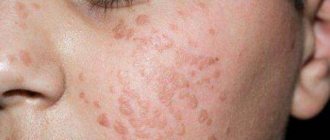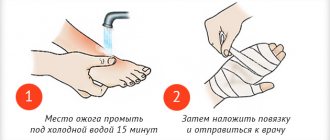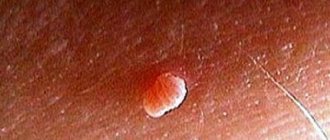The situation when a papilloma comes off is far from uncommon; these neoplasms are very fond of such areas of our body where they are easy to injure.
In this case, there is no need to panic, but you should still be armed with some knowledge about the procedure for your actions. Those with papillomas know very well how much moral distress these small growths on the skin of the body sometimes cause.
Just by their appearance, they can easily ruin your appearance or even cause physical discomfort. Therefore, the desire to get rid of warts (also called papillomas) is quite understandable.
If the papilloma comes off, you need to save the fallen element and contact a specialist.
ALL INFORMATION ON THE SITE IS FOR INFORMATIONAL NATURE AND IS NOT A GUIDE TO ACTION! ONLY A DOCTOR CAN GIVE YOU AN ACCURATE DIAGNOSIS! WE ASK YOU NOT TO MEDICATE YOURSELF, BUT MAKE AN APPOINTMENT WITH A SPECIALIST! HEALTH TO YOU AND YOUR LOVED ONES!
But not everyone knows what to do if the papilloma comes off on its own. This situation can cause great concern, so let’s take a closer look at what to do if this happens. ROUTES OF HPV INFECTION The human papillomavirus (HPV) enters the body through tiny lesions in the skin and mucous membranes.
Basically, this occurs through direct contact with a carrier of the virus. By gaining a foothold and multiplying in epithelial cells, the virus leads to disruption of their functioning. A person notices a neoplasm in himself in the form of a growth, the shape and size of which depend on many factors, including the subtype of the virus, its location and the way the virus entered the body.
Infection through close contact Among the different methods of infection, HPV prefers the following: through unprotected sexual contact.
This is the most common route of transmission of the virus. The consequences of infection will most likely not be long in coming in the form of growths. They are usually localized in the anogenital area, that is, on the external genitalia, in the anal area, in the vagina; during labor from mother to baby. In such cases, papillomas most often appear on the mucous membranes of the nasopharynx or eyes.
That is why it is advisable for women to be examined in advance and treated for the disease before childbirth, or better yet at the stage of pregnancy planning; household way.
Doctors do not exclude this method of penetration of the papilloma virus into the body, since it remains active in the external environment for some time. Particularly favorable conditions for this arise in warmth and high humidity, that is, when visiting public baths, saunas and swimming pools, you should be especially careful.
Neoplasms can appear on the neck, in the armpit, on the fingers, hands, and soles. A person may not be aware of his infection for years. The virus is usually activated when immunity is significantly reduced, and until this time exists in an inactive phase.
The main symptom of HPV infection is the appearance of growths on the skin or mucous membranes. Of course, it is not always possible to independently determine that such neoplasms are papillomas.
Therefore, you will need to consult a doctor. The appearance of warts may be accompanied by other symptoms: itching, tingling and even pain. However, such manifestations are not typical for all types of papillomas (for example, flat and plantar) and are felt infrequently.
Men most often notice papillomas only when they are injured or if the papilloma is inflamed. This usually occurs when shaving or rubbing with clothing.
Most often, such warts are located under the armpit or in the groin area. New growths on the head of the penis do not go unnoticed. They can interfere not only with sexual intercourse, but also with urination. Naturally, in such cases you should immediately consult a doctor. IN WOMEN Women are most often concerned about papillomas as a cosmetic defect. A growth on the face, neck or hands, of course, does not decorate the fair sex.
And even if it does not manifest itself as unpleasant sensations, it is easily injured by jewelry or during daily cosmetic and caring procedures. Papillomas in the vaginal area, especially those located on the cervix, pose a real threat to health. The least that can be expected from them is tissue erosion. The danger of this condition is that it is often asymptomatic and cannot be detected without a doctor’s examination. And neglected, untreated papillomas in this area can begin to degenerate into malignant formations.
It is not at all uncommon for a papilloma to come off. This is especially true for small formations on a thin stalk in the neck, armpits or groin.
It is easy to pick off a wart here even when changing clothes or shaving. At this moment, you can feel pain and notice that blood has begun to flow.
Characteristics of papilloma and its structure
Characteristics of papilloma and its structure
As mentioned earlier, with HPV, benign neoplasms appear on the skin and mucous membranes. They can have a different shade (from beige to dark brown) and protrude slightly above the epidermis. Once the infection enters the body, it spreads quickly. Growths appear on the skin.
A wart can have different forms depending on the variety:
- flat;
- threadlike;
- cone-shaped;
- coralliformes.
They have a dense, scaly, hard structure. They can be formed in single quantities or in groups. Structure:
- dense upper part;
- epidermis;
- dermis;
- root;
- fatty tissue.
A wart can cause adverse effects. Therefore, it may be necessary to remove it. The doctor decides what to do with unwanted papillomas.
In what cases should you consult a doctor?
You should consult a doctor for help when the first warts appear. The doctor will conduct an examination, prescribe tests, and special diagnostics. Allows for timely removal and initiation of antiviral therapy.
If damage occurs, be sure to consult a doctor.
The doctor will suggest treatment. May recommend removal immediately or some time after conservative therapy. Preference is given to special devices.
When there is no obvious injury, but there are symptoms of inflammation, it is recommended to see a doctor. Danger signs include:
- the appearance of erosions on the surface of the cone;
- swelling, redness of the formation adjacent to the skin or mucous membrane develops;
- increase in local temperature;
- pain is noted;
- the growths begin to itch, itch, bleed, and change color (lighten or darken).
This indicates the development of an infection. When the process is severe, lymphadenitis occurs - enlargement of the lymph nodes.
Is it possible to tear off papillomas?
Is it possible to tear off papillomas?
People often have a question: is it possible to tear off and cut out papillomas on their own? After all, it brings discomfort, and it is not always possible to consult a specialist. In addition, it is not uncommon for a person to accidentally tear off a growth until it bleeds. Because the wart likes to appear on areas of the skin where it can easily be damaged.
Injury to growths most often occurs in the groin area, neck, face, and armpits. In places where clothes rub against it, it can get caught on foreign objects. A wound appears at the site of the injured neoplasm. An infection can easily spread there.
Some strains of benign neoplasms can degenerate into oncological pathologies. This is often observed if the wart has fallen off as a result of damage or you have cut it off or squeezed it out. That’s why you can’t tear off growths on your face, body, or neck.
Is it possible to cut off a wart yourself? We figured it out. You need to know what to do if an injury does occur.
What measures should be taken
If the neoplasm turns out to be disrupted, do not panic. You just need to follow these steps:
- Treat the wound with any antiseptic: brilliant green, iodine, hydrogen peroxide, potassium permanganate or medical alcohol.
- Apply a bactericidal patch to this area or apply a sterile bandage.
- Make an appointment with a dermatologist.
An examination by a specialist consists not only of a thorough examination of the skin surface.
Laboratory studies and tests will also be needed, on the basis of which it will be possible to say whether the papilloma was benign or malignant. If the growth has not fallen off completely, but has only become torn, then similar measures are taken. If you feel normal and there are no accompanying symptoms: redness, swelling, itching or burning, there is no need to rush to visit a doctor. But still, you should not wait for the next injury, but get examined as soon as possible.
What to do if you get a papilloma
What to do if you cut off a papilloma
The answer to the question whether you can cut off a wart yourself is negative. But it happens that the patient accidentally damaged the papilloma (shaved, tore off, cut off, fell off due to friction with clothing). If a papilloma accidentally comes off, you need to provide first aid to the victim. What to do if you accidentally rip a papilloma:
- If you pick off a papilloma or cut it while shaving and it starts bleeding, you need to stop the bleeding.
- How to stop bleeding: treat the damaged area with a cotton swab dipped in hydrogen peroxide.
- The tear site is treated with an antiseptic. It is advisable not to paint, in order to notice the occurrence of an inflammatory process in time.
What to do next if you pick off a tumor:
- Cover the area where the papilloma was cut off with a bactericidal plaster.
- If the patient has cut off a growth with a razor or was otherwise injured, you should consult a specialist. He will decide what to do if the patient tears off a wart.
The doctor determines whether the growth can be removed or cut off surgically. After the diagnostic measures have been carried out.
How can you accidentally damage a growth?
Modern dermatology has a whole range of tools and techniques that allow you to get rid of tumors on the skin. However, some people do not dare to see a doctor, but try to rip off the unwanted papilloma with their nails or cut it off with scissors. In addition, formations can be damaged accidentally. For example, a small child may tear it off while playing or during exercise.
Most often, damage occurs as follows:
- friction of clothing,
- scratching insect bites
- washcloths or brushes when bathing,
- straps and handles of bags,
- razors.
In this case, the neck is the most vulnerable part of the body: chains and other jewelry can easily damage the tumor.
Sometimes a person may mistake a newly appeared papilloma for a pimple and simply accidentally pick it off with his nails. And only then discover that the papilloma has come off after all.
Consequences and complications
Often people self-medicate at home and don’t even know what will happen if they tear off a growth on the neck or in other areas, whether it is dangerous. If you shave or pick off a wart, the consequences will be as follows:
- As a result of damage to the tumor, the infection will spread to healthy tissue. The growths will become extensive.
- If an infection enters the wound from a damaged tumor, an inflammatory process will begin. Possible blood poisoning.
- Papilloma can degenerate into a malignant neoplasm. In medical practice, there have been many cases where a wart has transformed into melanoma (skin cancer). Oncological diseases in most cases lead to death.
An unsightly cosmetic defect (scar, scar) may remain at the site of the damaged neoplasm. This is the best case scenario. Therefore, if an unevenness or a red spot appears around the wound, you should immediately contact a medical facility for help. Such symptoms indicate an inflammatory process.
Possible consequences of separation
If a papilloma is torn off, a dermatologist can explain to the patient what will happen next. If a papilloma is torn off, it can provoke the following processes:
- If you remove the papilloma yourself, a wound may appear that will bleed for a long time. It can easily be joined by a secondary infection.
- The tissue may become inflamed at the previous site of the growth, and a burning sensation or itching may also appear in this area.
- The risk of complications increases with involuntary scratching of the wound, which leads to inflammatory processes and abscesses.
- Viruses from damaged tissues become more active and, when spreading, contribute to the formation of new formations. Having gotten rid of one papilloma incorrectly, the patient contributes to the appearance of a new growth or even a whole group of tumors.
- Accidental injury or unprofessional removal of benign growths can be the starting point for the formation of a malignant tumor, which can be fatal.
Not only tearing off, but also ordinary scratching of the growth can provoke the development of unwanted reactions in the future.
A person should handle any manifestations of papillomavirus very carefully.
Removal methods
Removal methods
You can get rid of an inflamed benign tumor in the following ways:
- Laser removal. This technique is very popular. It is the most secure as it is performed remotely. The risk of infection is minimized. Laser therapy is highly accurate. It can be used on even the smallest growths. After using the laser beam, there are no scars or cicatrices left on the skin. The event is based on the effect of laser on papilloma cells. They heat up and evaporate. The procedure is done quickly. The wound heals after it in a short time. It does not require special care.
- Papilloma can be removed using radio wave surgery. It is carried out in the same way as non-contact laser therapy. The neoplasm is exposed to high frequency radio waves. The removal technique is suitable for all types of papillomas. The procedure is painless and takes place without blood. Rehabilitation after surgery takes a minimum of time.
- Cryodestruction. The method is based on exposing the affected area to liquid nitrogen at a very low temperature. Benign tumor cells die instantly. The growth disappears on its own. The procedure is very effective against tumors on the cervix and rectum.
- Electrocoagulation. The procedure is performed using an electric knife that emits current of various frequencies. The neoplasm tissues die. All the liquid from it evaporates. The growth falls off. Surgical intervention is performed using special equipment. It makes it possible to regulate the power of the impact. Using electrocoagulation, growths of various sizes and depths can be eliminated.
- Surgery and exposure to lactic and salicylic acids. These techniques are irrelevant today, as they are traumatic and leave marks on the skin. It takes a lot of time for a wound to heal. They are used only in extreme cases. When other methods are contraindicated for some reason.
Each method of removing growths from HPV has contraindications. Only a doctor can choose the safest and most effective treatment method.
Why is tearing off papillomas dangerous?
Tearing off papillomas on your own can be very dangerous.
Do not apply medications containing chemicals to the wound to get rid of warts. For example, products based on lactic, salicylic or acetic acid. In addition, the application of phenol-containing solutions is not allowed. This group includes Superchistotel, Ferezol, Kolomak and Duofilm. Such self-medication will lead to disastrous consequences.
If brown dots are visible in the place where the papilloma was located, under no circumstances should they be cut off or removed with tweezers. Some people mistakenly believe that these are the roots of papilloma. In fact, such points are capillaries that have been injured. Their removal will contribute to the expansion of the wound and greater growth of the formation.
If the growth is damaged during shaving, the razor used for the procedure should be thrown away immediately. This will prevent the virus from spreading to healthy skin.
What happens if papillomas are not removed?
What happens if papillomas are not removed
In some cases, there is no need to remove papillomas. They may disappear on their own:
- if the growths arise due to a temporary decrease in immunity: stressful situations, overwork, short-term illnesses;
- when neoplasms formed during pregnancy;
- if papillomas are observed in children and adolescents.
This does not apply to condylomas (formations on the mucous membranes of the genital organs). Such growths do not go away on their own. They need to be disposed of medically. If not removed, they can easily be injured at home. This leads to complications that were described earlier: the introduction of additional pathogenic microorganisms into the wound, blood poisoning, transformation into a malignant tumor, and the spread of infection to healthy tissue.
To avoid these adverse effects, it is recommended to remove the wart. This should be done under the supervision of a specialist.
Can it disappear on its own?
Despite their benign nature, papillomas are formations that cannot disappear on their own. Such growths disappear only under mechanical influence. But this does not happen with all papillomas, but only with thread-like ones or those that have a thin base (neck).
If the papilloma has come off, then you cannot turn a blind eye to it. If there are no visible signs of inflammation at the previous site of the tumor, this indicates that there is a sufficient amount of antibodies in the body that can suppress the virus. But if the tissues are swollen and inflamed, it is recommended to consult a dermatologist.
Can papilloma develop into cancer?
Currently, science knows more than 6 hundred strains of HPV. More than 50 varieties of them have increased oncogenicity. This means that if a person becomes infected with at least one such virus, papillomas can develop into cancer. Papillomas that are located on the genitals of women are especially dangerous. Cancer and the human papillomavirus have a special relationship. If there are several strains of HPV in the body at once, this will increase the risk of cancer.
Most often, women become infected with this virus. This is facilitated by a very high level of estrogen in the body. Such hormones are a favorable environment for cancerous changes in the genital organs. Therefore, if a representative of the fair sex accidentally tore off a papilloma, she urgently needs to visit a specialist. This must be done even if she accidentally knocked off such a formation.
Detachment and degeneration of growth
It happens that papillomas dry out on their own, darken and fall off. This can occur as a result of taking drugs that enhance immunity or vitamin complexes. In addition, neoplasms can appear and disappear with changes in hormonal levels. Thus, in pregnant women, papillomas often appear on the chest and abdomen, and disappear after childbirth.
The spontaneous disappearance of tumors indicates an increase in the body’s defenses or the elimination of factors that activated HPV.
Sometimes a small papilloma begins to grow and change color. Most often this happens when it transforms into another neoplasm - hemangioma. This is a benign tumor consisting of vascular tissue. It has a rich crimson or dark purple color and protrudes several millimeters above the surface of the skin. After a thorough examination, this formation can be eliminated using one of the minimally invasive methods.
It is recommended to remove papillomas and other unwanted growths on the body without waiting until they become a source of problems or complications. To do this, you need to go to a specialized clinic with an experienced dermatologist or cosmetologist.
You need to take care of strengthening your immune system, lead a healthy lifestyle, give up bad habits and be less nervous. Then the body itself will be able to give a worthy rebuff to any diseases.
general description
Papilloma is a neoplasm that appears on the skin, resembling a wart in appearance. But the bulge forms on the “leg” and often has a hanging character or is located directly on the base.
If you feel the growth, it will resemble a rooster's comb. The color of the formation can be completely different - from pale to brown. Neoplasms can appear singly or in groups.
The location can be any body area - neck, back, eyelids, chest, skin folds. The inconvenience caused by the growth leads to the need to remove the papilloma yourself as quickly as possible. But how safe is it, and is there any point in this action?
What else you need to know about HPV
The papilloma virus is transmitted through household and sexual contact. Different types of viruses are responsible for the formation of genital warts and papillomas. Genital warts in the groin are removed by a surgeon. If you have a lot of papillomas and they appear frequently, you should undergo an examination. Not all warts can be detected visually. Papillomas on internal organs are detected only during diagnosis.
HPV causes erosive processes in the internal female genital organs. HPV increases the risk of developing cervical cancer. In men, genital warts may be the first symptom of penile cancer. This does not mean that every condyloma will necessarily turn into oncology, but a close look from a physician is necessary. To timely monitor the disease, women regularly visit a gynecologist, and men - a urologist. You will need to do an HPV test, undergo an ultrasound and other tests.
Why you shouldn’t tear it off and damage it
HPV sufferers are aware of the consequences of traumatizing elements and try to avoid cutting, picking and tearing out.
Papillomatosis is a disease that affects large areas of the body, where hanging and flat formations appear.
The danger comes from growths and moles on thin stalks located on the eyelids, groin, armpits and chest area.
A dangerous type is condylomas, which affect the genitals and butt (anus). They are transmitted sexually and can be injured during sexual intercourse. If damage occurs, the consequences will be negative.
Spread of the virus
If the papilloma comes off, a small part of it will remain. Pulling out the rest of the growth yourself is dangerous. The virus begins active cell division, spreading, popping up in new places, and instead of one formation, two new ones may emerge. According to ICD-10, growths on the eyes can lead to the development of chronic eye diseases and blindness. Formations located in the roof of the mouth cause respiratory spasms and are the focus of the development of oncology in the larynx. The tongue, covered with growths, loses sensitivity, the nasal cavity loses its sense of smell. The virus is so dangerous that it even affects dogs.
Risk of inflammation or suppuration
Need advice from an experienced doctor?
Get a doctor's consultation online. Ask your question right now.
Ask a free question
An infection enters the damaged growth, causing inflammation and suppuration. The inflammatory process is accompanied by pain, redness of the skin, bleeding and discharge of pus, which is caused by an infectious agent affected by injury. If the papilloma is on the nipple, during pregnancy it will increase in size; after childbirth, during breastfeeding, the child may accidentally tear it.
Saliva enters through the tear, causing inflammation.
The danger comes from cuts left after shaving the face, under the arms and intimate area. If not treated promptly, the moist environment provided by sweating is a good breeding ground for bacteria. On the back, shoulders and chest area, formations are injured by the bra.
Inflammation accompanied by a purulent process is dangerous due to the appearance of ulcers that can burst and spread infection.
Other consequences
The risk of degeneration into a malignant tumor increases significantly when the type of virus is determined as an oncogenic strain. Trauma accompanied by infection causes complications:
- skin irritation;
- change in color and shape, the growth may darken;
- swelling of the skin around the papilloma, which may become swollen and red;
- severe pain when touched;
- itching and burning appears, the inflamed area begins to itch;
- discharge of pus with elements of blood, accompanied by an unpleasant odor.
If medical care is not provided in a timely manner - the injury is treated according to all the rules, the pathology will spread to nearby areas of the skin.
If alarming symptoms appear, contact a dermatologist or oncologist immediately.
The doctor will establish an accurate diagnosis and prescribe treatment for the patient to eliminate dangerous consequences.
Pregnancy with papilloma virus
Infection from mother to fetus during childbirth occurs in almost 98% of cases. For a baby who passes through the birth canal, literally strewn with condylomas, the virus enters the mouth and eyes, so all women planning a pregnancy should be tested in advance and, if necessary, treated for HPV and all types of STDs. Only after completion of treatment can you plan to conceive.
If the disease was in a latent form and was first discovered during pregnancy, and this happens often (immunity weakens during pregnancy), then it is necessary to urgently consult a doctor: treatment of papilloma during pregnancy is possible.
Causes of papillomas
The main reason why a benign tumor forms is infection with the virus through domestic or sexual contact. HPV can remain in the body for years, but manifest itself under favorable conditions. Reasons that provoke neoplasms in different parts of the body or mucous membranes:
- weak immunity;
- stress, depression;
- long-term use of medications;
- frequent change of sexual partners.
The structure of papilloma and warts is stroma (base, island) with connective fibrous tissue. Localization - on the face, neck, eyelids, external genitalia, chest, armpits.











